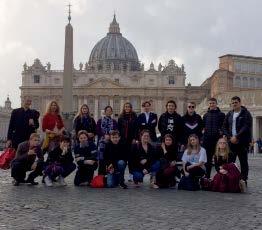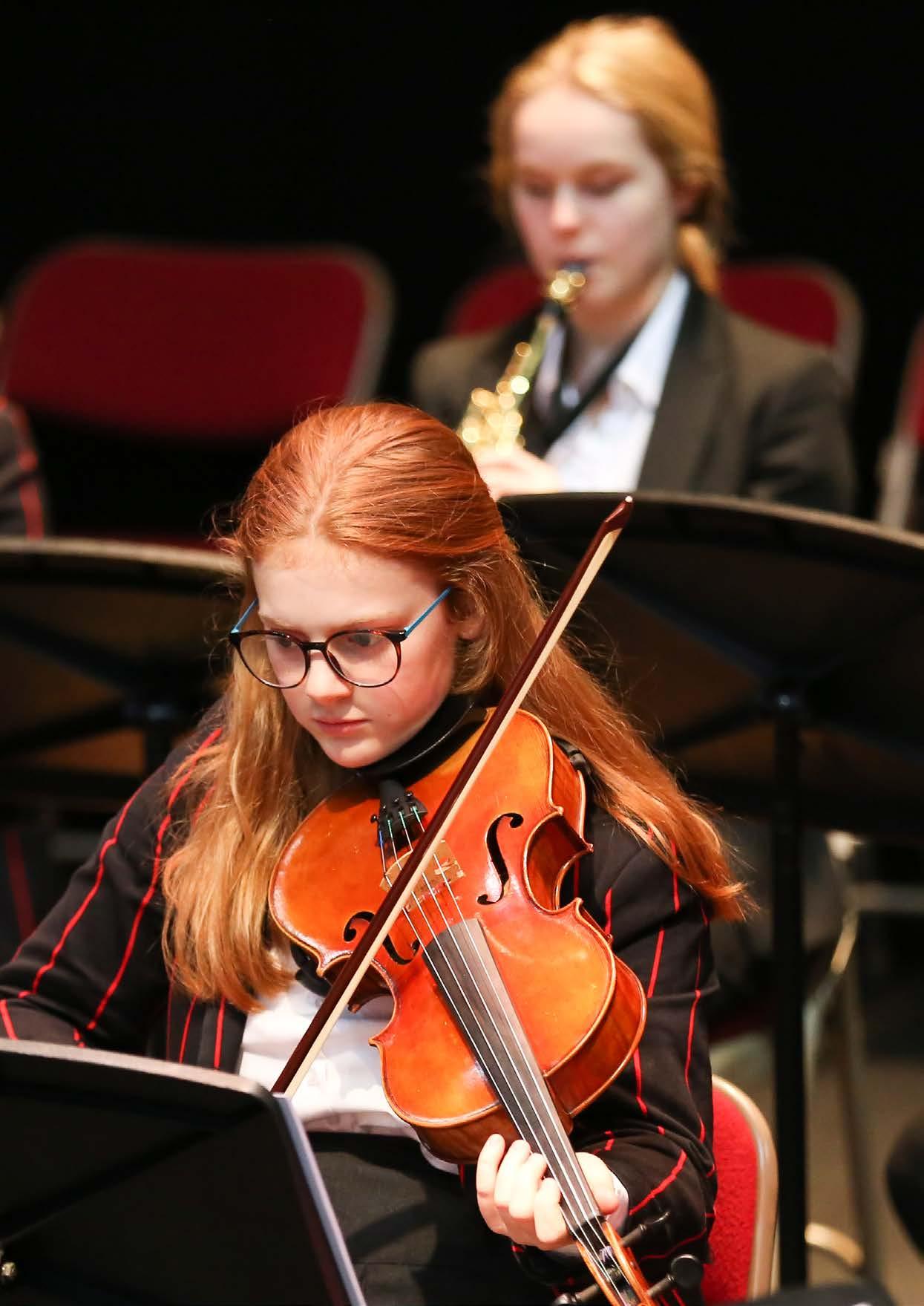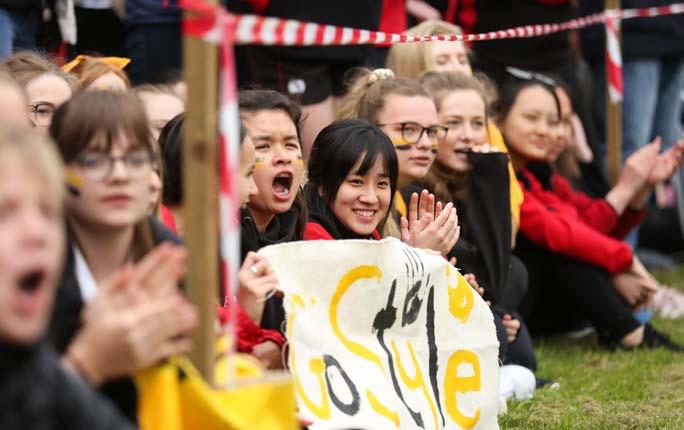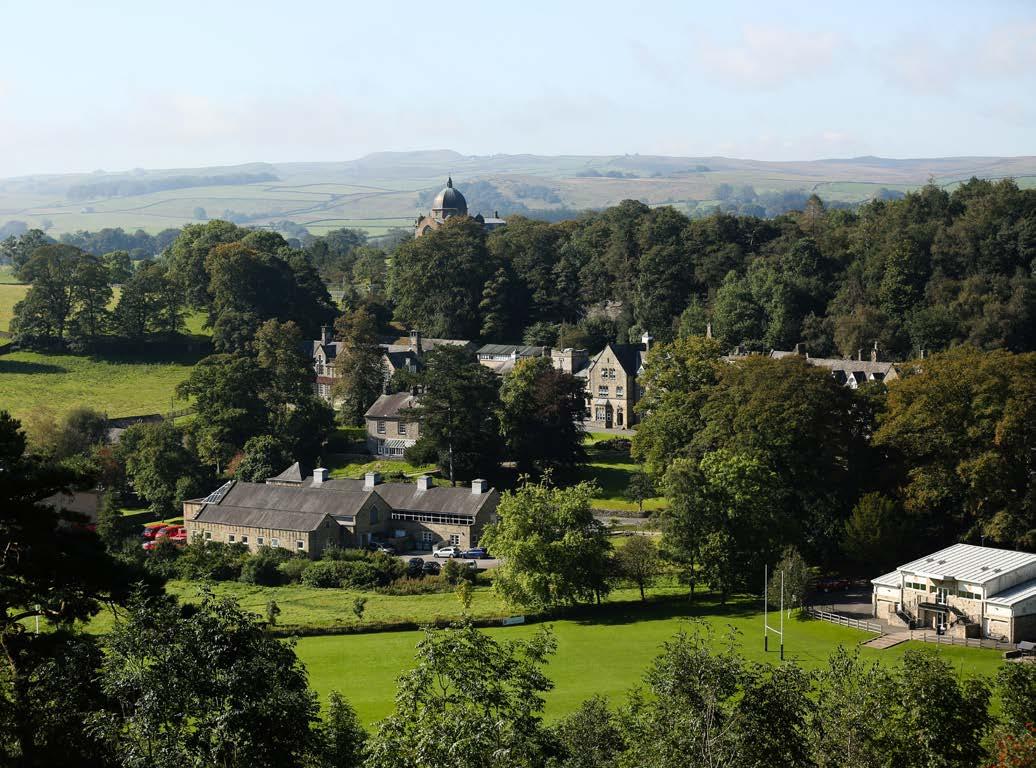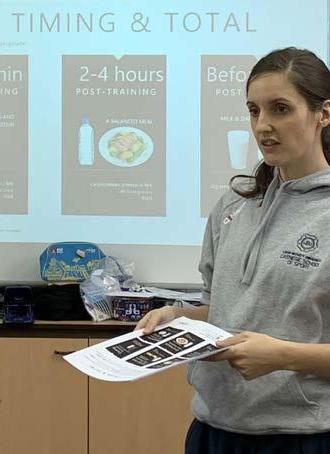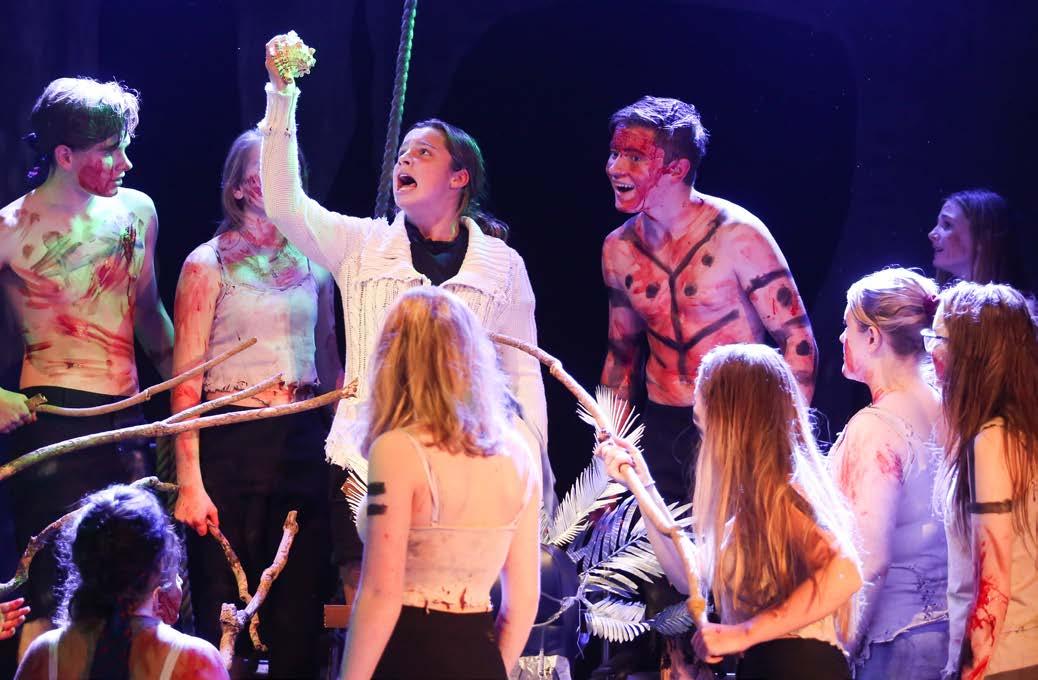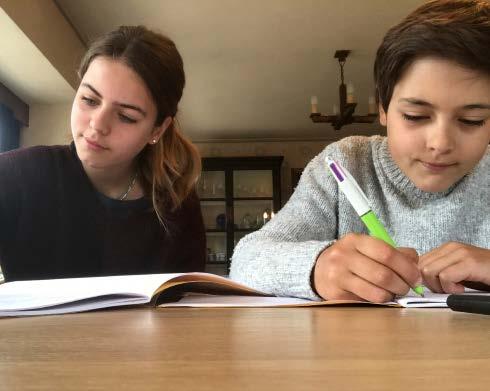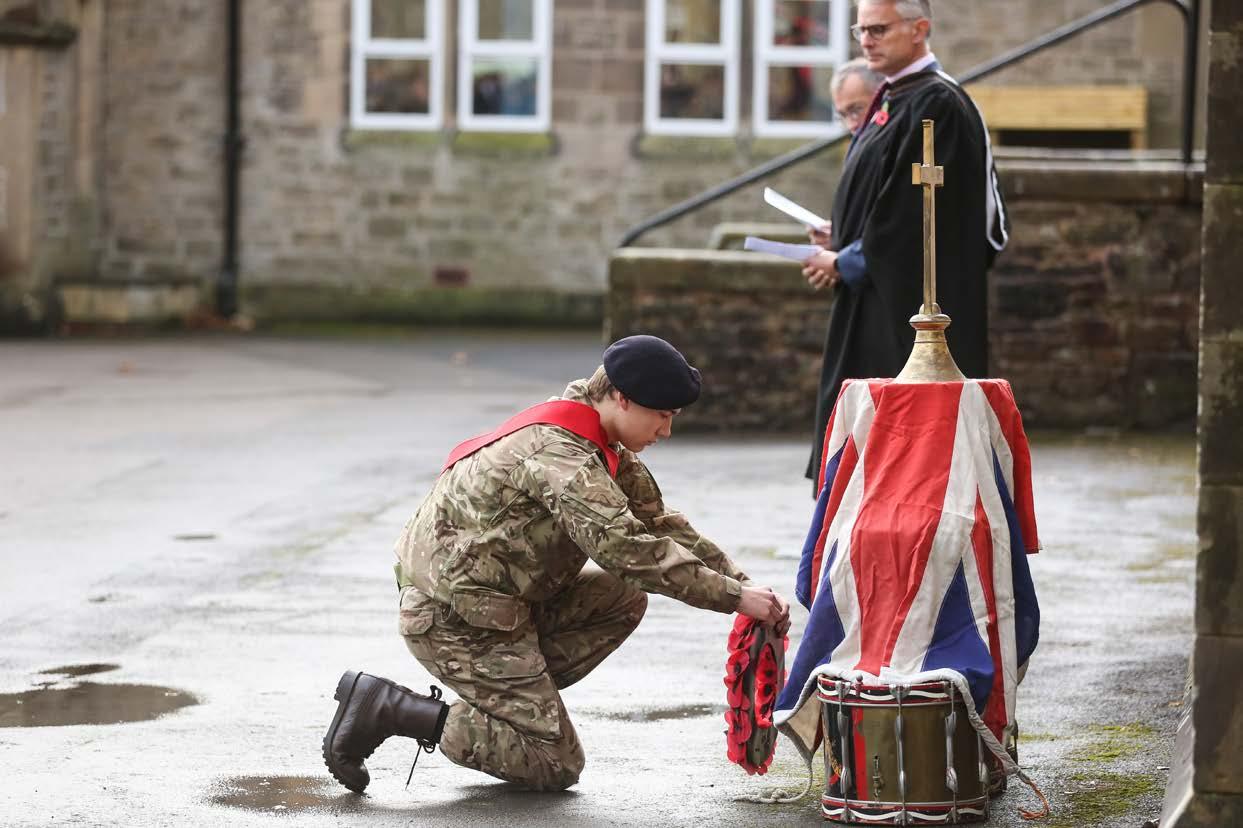
30 minute read
Academic
Review Academic
NECESSITY IS THE MOTHER OF INVENTION
Advertisement
Anna Wood reviews the academic year for us. She shares with us her passion for teaching and learning in the most challenging year of her career. But as we know, challenge is something we embrace at Giggleswick.
Iembarked on my teaching career in 1992 and, if you had said to me then, that in 2020 I would be teaching my classes via a computer screen from my kitchen table, I would probably have laughed you out of town. We had two computers back then in the staff room and communication was either done face-to-face, or a piece of paper with the massive black heading MEMO was placed into your pigeon-hole in order to grab your attention. Reports were written on paper, backed by a carbon copy, and if you made a mistake you had to rip it up and start again. Monthly assessments were handwritten into a spreadsheet that was passed from teacher to teacher – said spreadsheet was then photocopied and distributed. I could almost write a ‘Monty Python’ sketch at this point called The Four Teachers, but the point I am trying to make is that in a
relatively short amount of time, we now find ourselves in a whole new educational paradigm and on 23rd March 2020, that paradigm shifted once again as we entered lockdown. Fortunately for us, John Hamilton had had the foresight to introduce us to Microsoft Teams a year before and we had slowly begun to build our knowledge of this new communication tool. By September 2019, we were creating class teams and setting prep via Teams; some were pushing ahead and using the class notebook and One Note. Then came the introduction to video calling and setting up calendared on-line meetings. The Monday INSET session for teachers gave us the opportunity to practise sharing our screens and uploading work – competency ranged from ‘This is easy - what can I learn next?’, to ‘Which icon do I click on next?’, to ‘It’s not working!’ As a teacher, I had never found myself on such a steep learning curve. But being out of one’s comfort zone can be an exhilarating experience and the pandemic, which was devastating and disruptive, gave us an opportunity to change our practice and become learners again. And that for me is probably what I value the most about the period of the Summer Term 2020. Teachers often forget what it is like to be a learner, and this can often be to the detriment of learning in the classroom. So, when I conducted my first online lesson from the kitchen table on 24th March, I became a learner again and was reliant on the good grace of the learners at the end of the screen. Over Easter, we made the decision to launch the Virtual School. We knew that we did not want the Virtual School to be just online learning as Giggleswick is so much more than that. The Virtual School was specifically designed to reflect the importance of community. I totally agree with Professor David Crystal who has taken exception to the newly constructed Covid phrase ‘social distancing’, preferring the phrase ‘physical distancing’. We found ourselves physically distanced, but through the Virtual School we achieved ‘social cohesion’ – which is what we all needed at a time of upheaval. That is why the Virtual School timetable was constructed thoughtfully to include tutorial time, assemblies, chapel, lectures, games and club activities – in other words, the usual activities but repackaged in a manageable format that carefully considered the fatigue brought on by staring at a screen all day. As staff, we took advantage of the Microsoft Educator training courses to upskill – the aim being to keep our pupils as engaged as they are in the classroom and to continue to build strong teacher/ pupil connections in the remote environment. Whilst some flipped the classroom, others ‘Swayed’ and I got hooked on Flipgrid –a video gallery that allows pupils to add their ‘vox pops’ on any subject. My particular favourite was when my Year 10 German pupils took me on a tour of their houses, describing the position of furniture using the Dative case. Staff and pupils alike totally bought into the Virtual School and for some pupils who sometimes struggle in the usual classroom environment, remote learning saw them achieve and progress in leaps and bounds. The Virtual School was a resounding success as it was underpinned by all our values. Whilst other schools shied away from live face-to-face video lessons owing to fear of inappropriate behaviour, we proceeded with confidence that our pupils would respect the guidelines we put in place and would fully participate in all that was on offer. And there was certainly no lack of ambition, either from the staff who pushed themselves well beyond their comfort zones, or from the pupils who continued to learn, progress and create solid foundations for their return to school. Year 11 and the Upper Sixth did not miss out either; whilst many schools bid their leavers farewell, we designed a whole range of pre-university courses and A-level bridging courses that were exciting because they were not bound by any specification. The sign-up rate was almost 100% and the drop-out rate was minimal – again, testament to the quality of the product and the willingness of the pupils to engage. At the same time as delivering the Virtual School, staff were also asked to award pupils in Upper Sixth and Year 11 centre-assessed grades. The professionalism and integrity shown by Giggleswick staff was of the highest order. The two-week consultation process, data crunching and decision making was not something any teacher would ever want to have to do, but I am very proud of the way the process ran. Our Upper Sixth and Year 11 pupils may well have felt very disappointed and maybe even cheated that they could not demonstrate their ability in end-of-year exams, but they can rightly hold their heads up high owing to their results: 72% A*-B at A level and 48% 9-7 at GCSE.
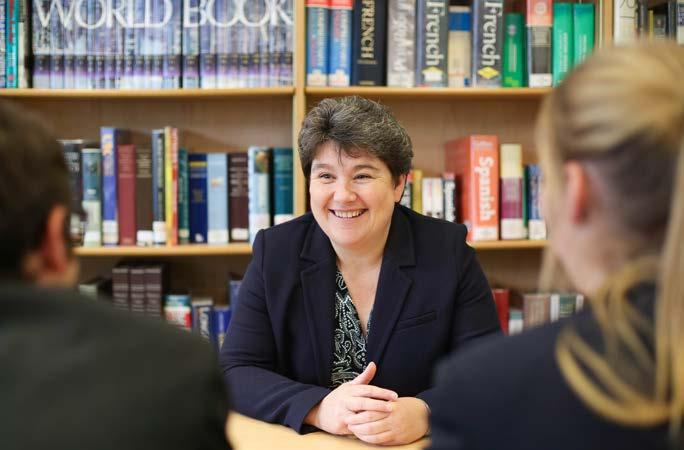
GIGG WRITES
This year has seen the launch of one of our most ambitious and exciting literacy initiatives. The passion for writing goes from generation to generation.
Words have power. Words have the power to move us, to guide us, to influence us and to deceive us. They have the power to create landscapes and bring to life people who become our friends or our enemies. Words can place us shivering, listening to the dull thud of bombs, knee deep in the cloying mud of a First World War trench. Words can uproot us into a future where buildings lie crumbled and broken and where we hide amongst the debris, clinging to the tatters of civilisation. Words can share with us the agony of lost love or the unbridled joy of discovery. Words show us life. Perhaps more than that, words are life. Human beings need stories to help them understand the world around them. We need stories to make sense of our place in that world. We need people to write these stories. That said, writing is like anything else: you have to work at it. It takes time, determination and effort. You have to give yourself the space to think, to plan and, ultimately, to write. The philosophy behind the ‘Gigg Writes’ competitions was to do just this: to give people the motivation and the opportunity to write. Launched in November by the English Department, the monthly ‘Gigg Writes’ writing competition was designed to encourage people to make the time to write. Each month, the first line of a well-known novel was used as a prompt. Chosen texts ranged from classic novels such as Jane Eyre and Wuthering Heights to contemporary fiction like Internment by Samira Ahmed or One by Sarah Crossan. The prompt sentences presented different perspectives, different time periods and different scenarios. The form of the challenges also varied: some were to write 500 words, others to write 50 words; some were to write prose, others to write poetry. Entries were judged by ‘real’ writers: poet Paul Welbourn, journalist Hilary Mitchell, TV Producer and comedy writer Russell Balkind, best-selling and award- winning authors Alison Wilcox, SE Moorhead, Marcus Sedgwick, Susan Fletcher and Stacey Halls. As soon as the competition was
launched, entries began to flood in. In total, 350 entries were submitted from students, staff, parents and OGs over the course of the year. All the judges commented on the high standard of entries and the talents of the entrants, several of them suggesting that the winners could easily go on to have successful careers as writers in the future. As an English teacher, it has been a delight to see people writing, not to pass an exam nor achieve a grade, but because it is simply an enjoyable thing to do. The support from the whole Giggleswick community has been tremendous and I would like to thank everyone for the time and energy that they have put into entering. I look forward to reading much more of your work next year.
Karen Peacock
SOME OF THE WINNING ENTRIES James Cobley – Year 11 I strain to listen for boots on the pavement. I quiver in my submissive position, grasping at anything from the faint hum of insects flying around to the silent tiptoes of feet. But, unfortunately, there is nothing. I can only hear the occasional fading rumble of a car in the distance. My ears are throbbing from the sound of stray bullets hitting the outside world. I hear them but don’t see them. Where am I? My head is groaning from this unbelievable pain. I cannot move; I can only feel what is beneath my perspiring fingers. The buzzing surrounds my insane state. Voices are muffled and foreign. I have been attempting to move my broken body for so long, but it will not obey. The date and time mean nothing to me; they are irrelevant when all hope is gone. The sound of gunfire and bombs exploding obliterates my ears. The ear-shattering sensation I hear is only dwarfed by the painful throbbing in my guts. It’s deep and warm; and not in a good way. It feels like someone has pressed their grubby hands inside me and are squeezing and squelching my organs into a gruelling mess as hard as physically possible. Like waves crashing against the shore, when the pain fades, I can move; when it returns, I can only hold still and breathe, breathe slow and deep until it has passed. There are
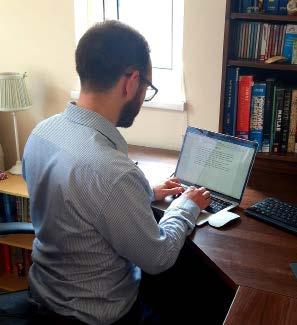
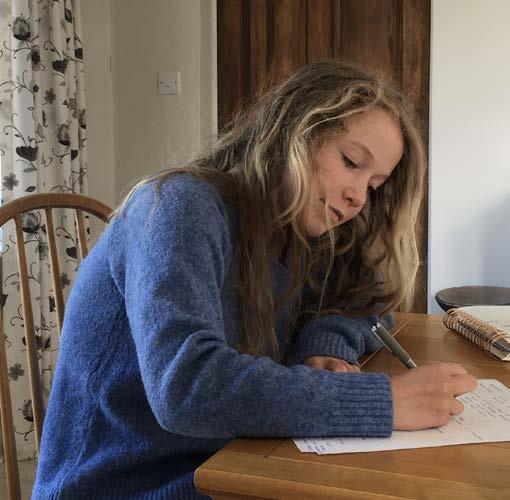
pools of lumpy blood splattered on the floor; my abdomen is purple and lumpy. It should be smooth. Every subtle movement or flinch I make I feel a sharp piercing stabbing my innards. If it wasn’t for my family, I would have just bitten the dust, but I promised to come home; so, I must. Then, the unimaginable happens. In a terrible flash, the heart that had been thriving for so long is torn from the city. Moments earlier there was still some sense of peace, now all that has been wiped out clean. Now, there is only blood, crumbling walls and a sense that all that is good in the universe has cried out in pain. I am thrown out of my hideout and thrust into open space. I lie there in agony and semi-blind amid all the chaos. Then, as I begin to recover my consciousness, I find myself standing by a pillar that seems miles from where I was kneeling just seconds before. I’m shocked at what I see. Scattered body parts are left flailing about amid shards of debris. I see survivors fleeing for their lives, dashing to any available shelter they can find. I want to help them. But my body is banging on death’s door. What makes matters worse are the growing sounds of pattering boots on the muddy, blood-soaked ground that 5 or so shell-shocked German soldiers are sprinting towards me. This is it. I sob at the thought of never seeing my beloved eight-year-old daughter again. My bones turn cold. The soldiers
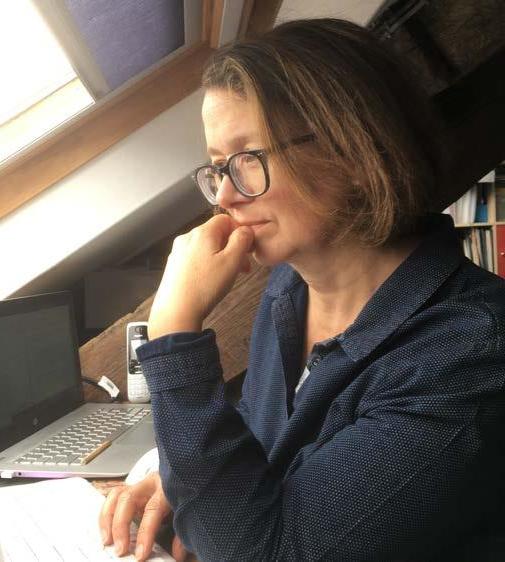
encircle me hollering harsh German commands at me, but it is no use though. My life is already over.
Nick Peat, Upper Sixth Yesterday saw the first snowfall of the year. This bleak season is cold and dark. It bears no chance for survival; any hope in a life hereafter vanished long ago. The sea of faith is frozen now; perpetual winter grips the heart. Like the first man, the snow will always fall.
Lily Whewell, Year 9 It was seven minutes after midnight. Moonlight cascaded through the cracks in the cream-coated shutters and the wind slowly battered the glass of the single pained window. Harriet was lying snugly in her bed. Her golden curls bounced gently with each heavy breath, her rosebud lips grinned blissfully in her dreamy sleep. She began to wriggle, disturbed by something as her nightdress slowly tangled and twisted into a cocoon around her long legs. A cold hand touched her shoulder, and she darted upright. A ghostly pallid figure put her finger to her lips and hushed Harriet to be quiet. The other girl had long dark hair which sat in a thin braid down her back. Holding out her hand, she helped Harriet out of her cocoon. Outside the rattling wheels of a carriage and the clatter of hooves against uneven gravel grew louder before it steadily came to a halt. “Enid? Is it time?” Harriet whispered. A girl across the dormitory began to stir, muttering something quietly under her breath before settling down into her blissful sleep. Enid carefully opened one of the shutters as moonlight poured into the room. The faces of tired, sleeping girls were illuminated softly by the glare of crisp night sky. A carriage awaited them in the drive. “Yes,” She replied. Harriet clambered out of her nightdress and into her Sunday dress. Buckling her shoes and grasping her coat, she retrieved the bag which she had tucked under her bed. A gold locket hung from her neck and she brushed her hair to try and tame her flowing locks. Enid awaited her at the door to the dorm. The hallway of the school was dark, unlike the dormitory. Darkness crept its way into corners and cast its shadow over doorways. The gentle clatter of their shoes seemed alarmingly loud against the floorboards. Large portraits which scattered the walls stared down at the girls, who clutched onto one another for comfort. Midnight was frightening. The door was bolted when they arrived at the entrance. Its large wooden presence gave a certain grandeur to the entrance hall, a complex pattern of metalwork littered its insides. It was in the girls’ bathroom that they found an open window. They clambered out clumsily, jumping from the ledge and landing with a crunch on the gravel. The night air was crisp and the sky was clear. Excitement buzzed like flies in the air as Harriet and Enid approached the black polished carriage. A tall figure greeted them at the door, offering his hand as he helped them one by one up into the interior of the carriage. sitting, grinning in the corner was a boy of about sixteen. He had raven black hair and a warm, summerblushed face, and was dressed in a smart black suit and tie. “Are you ready for the show?” he asked, his eyes glittering. “Yes!” the girls replied, looking at one another and grinning in absolute delight. Heather Hodgson, Parent Here we are. I never really thought it would come to this, but here we are. You had waited all day, and finally I arrived – you watched me glide in, wet hair, lean neck (ah, my sweet, sweet neck), sodden gloves. You watched as I made to cheer and warm this place, plump the fire, catch your eye. You have been yearning for my look, that glance. You have longed for our eyes to meet, stealing them away again should they linger too long, stare too hard. This is it, you think. She is here, she is mine. Again. Some will call me pigeon-livered, I am aware. They’ll refer to me as that roguish cluck, that wanton mistress, that scourge amongst women. I’ll hang for this, as you hung-on for me. My limbs will twitch as I gasp and splutter for my last breaths – and throughout the delicious ecstasy of dying, as clear as night is black, I will attest to having been the lover of a most exquisitely deranged young man. A man that was driven wild by passion and restrictions of society and fortune. My sweet, it was never you, it was always me. I enticed you to move my way, I
allowed you to touch my shoulders, kiss my cheek. Ah, how foolish are men? I took my chance, I made my move. I wrapped my golden plait about your nape. I pulled gently, tightly. You kicked for a long time, but inevitably you weakened as I knew you would. Too often we have met, in this cottage, by this lake. Too often the wind was wild, the rain foul, your temper unruly. No more may you summon, deceive and implore. Here we are, you and I. I hear the cries of men, and the gallop of horses. I shan’t have long to wait now, my love. I shall forever be your dearest Porphyria, your greatest love.
MIDDLE SCHOOL WORKPLACE VISIT TO AMAZON
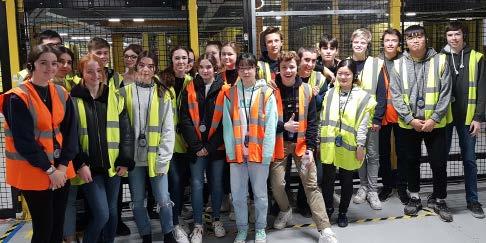
Giggleswick, bringing education to life by linking academic learning to real-life employability.
Workplace visits form an important part of Careers education and the recent Year 10 visit to the Amazon Fulfilment Centre in Manchester was a most informative and enjoyable trip. Students were given a real insight into the workings of this incredibly busy, highly automated warehouse facility and the roles of the hundreds of employees who work around the clock to ensure that tens of thousands of parcels are processed each day. Our knowledgeable guides readily answered any questions that the students had and allowed us to participate in the packing and processing of parcels. The facility only deals with small products and it was fascinating to watch the robotic storage system in full flow, with cages full of products seamlessly weaving in and out of each other on their way to the pickers. This was a great opportunity to get a ‘behind the scenes’ look at this global company and to gain a better understanding of the sophisticated technology used in modern distribution centres.
CONSCIOUS COASTERS: GIGGLESWICK YOUNG ENTERPRISE 2020
After a successful first year, Giggleswick’s next generation of entrepreneurs continued our innovative approach to learning. This time they are going green!
THE ENTERPRISE The aim of our product was to help raise awareness for the work of animal charities and the causes for which they fight. We did this by supporting animal shelters with advertising and using their dogs as the design for our coasters. At the trade shows we attended, and on our website, there was information about the local dog centres and also their contact details. The company also had plans to extend into sea-life coasters, whilst also planning to do beach cleans to help local communities with ensuring that the beaches were kept clean. Moreover, we also had plans to extend into Australian animals during the devastating bush fires in 2019-2020. Our idea was to create koala bear and kangaroo coasters to sell to the public whilst also raising awareness of the effects the fires were having on these animals. As a company we attended two Young Enterprise Trade Fairs (Asda, Harrogate and Skipton Building Society). During the trade fairs we attended, we managed to sell out of two varieties of our dog coasters. Furthermore, we also got valuable insight from the public on what else they would like to see us do, which included other breeds of dogs and even branching out into doing cats. At Harrogate, our target customers were people looking to buy gifts for their loved ones. The time of year meant that many customers wanted stocking fillers and our products met that demand. We won the overall best product award for this trade fair which gave the company confidence in branching out into other types of animals. In addition, the company also sold our products at the school’s Christmas Fayre, where we charged a premium price for our products which helped increase our profitability. As a company we also promoted our products in the school’s weekly newsletter, which allowed parents to place orders, where we priced our products at a cheaper rate to entice parents to buy our products. Another sales channel the company opened up was selling to local businesses such as gift shops and cafes. Here we sold the products at a discount as the businesses bought in bulk. In addition, the lower prices also meant that the businesses we were selling to could make a profit, but couldn’t undercut us on price.
THE JOURNEY TRAVELLED The planning stages, or the preliminary stage to our product idea, was a tricky one. We spent many meetings back and forth with different ideas of what was going to be the best ‘product’ that would sell. We had lots of things to consider in this process, such as scalability, how we would make the product, pricing, target audience – who would want to buy the product, how can our product be sustainable and make a difference in the local/ wider communities, what’s different and unique about our product that sets us apart from other markets/ sellers, and lastly, how can this product make money – where we would sell? With all these things to consider, it was
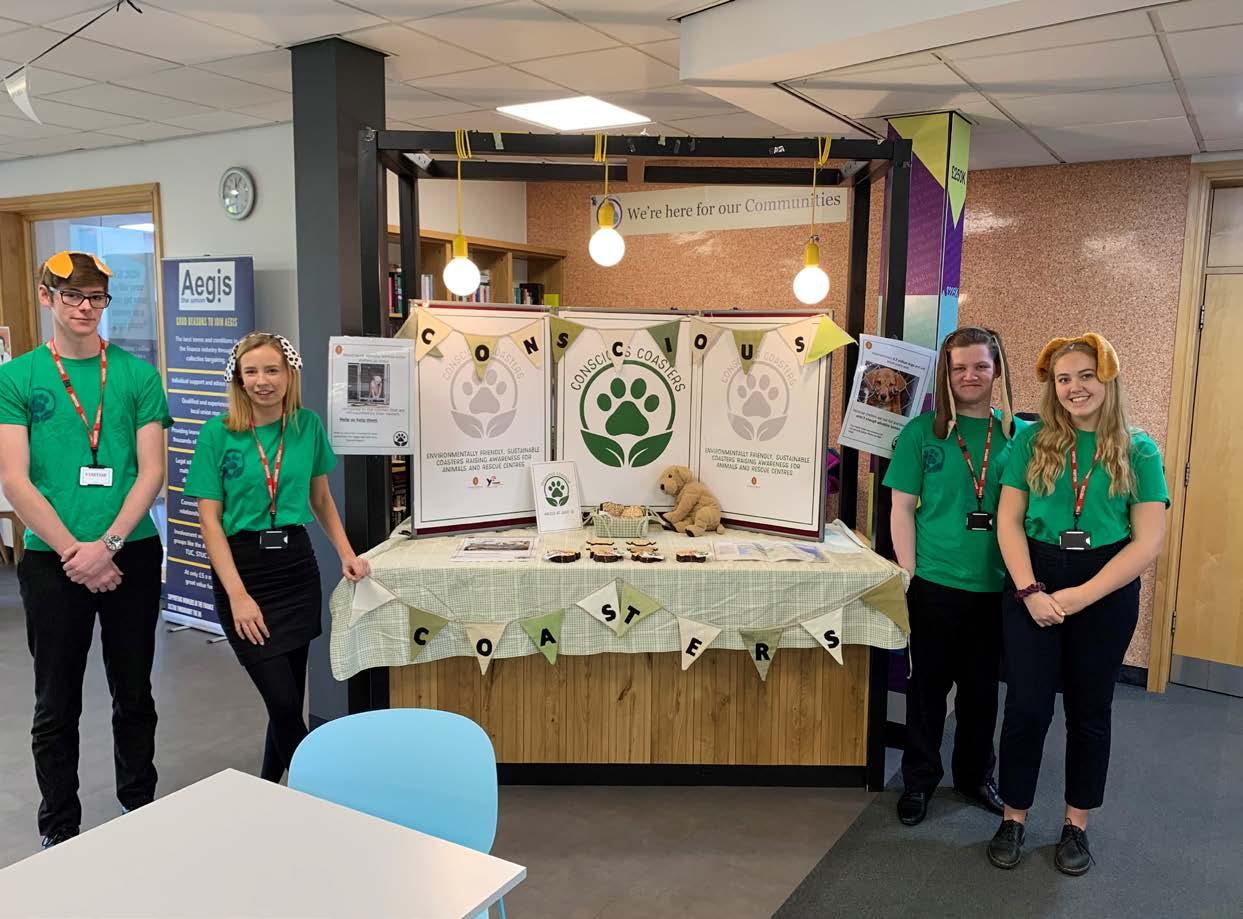
certainly a challenge to come up with and then decide what that product would be. We had ideas about door stoppers, draught excluders in the shape of endangered/protected animals, placemats with endangered species and messages on, re-used vintage clothes and selling those to different market places. Many people within the group could not decide what they wanted to do, others kept quiet and some were quite vocal because they favoured their idea. However, we learnt it took a great deal of communication skill to listen to each other and our ideas. We also learnt that it is not easy coming up with a feasible idea. If it was, then everyone would start up a business. Once the idea was set with coasters, the next phase came on - how to develop this idea. What would our USP be? How could we scale the product further? How would we be sustainable? All the three questions posed really came into one. They would be unique because we make the coasters in the shape of the animal (endangered) too. Market research showed that there were no other companies or coasters out there producing this. So we felt we had come up with something original. If the product was to extend further we would move into different animal groups with sea life and safari pack to show awareness with the use of our product around the world. With this came our sustainable mission to source eco-friendly wood, sourcing sustainable packaging such as reusing cardboard from the Art/DT department. We also surveyed staff, friends and the community about which designs they liked the best. We operated as a company with a conscious and sustainable vision by going paperless with all our meetings. Minutes were taken on MS Word by our company secretary Emily Guy who would, at the end of the meeting, send the minutes to our Young Enterprise Teams. This helped us all in being organised and making sure any communications that needed to be held were through there. All decisions before they were finalised were agreed by both managing directors so that we could both agree and move forward properly, without any ambiguity of what the next step would be. One of the biggest challenges we faced as a company was when our manufacturing facility (laser cutter) broke for one month. We heavily relied on the generosity of the Design Department to use the laser cutter for our production, but this halted all production of coasters for a considerable period. This blip in the process taught us how we must be adaptable in our strategies and processes. It certainly forced us to work together more as a team, as now we could not be reliant on a few individuals in the company to produce all such coasters. Designing, producing and packaging all takes a very long time. What all of us learned in the process of making a set amount of coasters each week, per person, was that everything is very time consuming. Managing time was essential if we were to perform the tasks productively and effectively. As
previously mentioned, there were various roles that we had to fill within the company in order to make it a successful running operation as possible. We had two designers, marketing, sales, finance, company secretary, HR and two managing directors. One may ask why we had two managing directors, but owing to the company being comprised of 16 members it was fairly large and we found it worked well and it was necessary for two people to share this role.
ENDEAVOUR, IMPACT AND RESULTS Our plans as a company were simple. We endeavoured to have a constant supply stock, expand into business-tobusiness selling, promote awareness, volunteer at animal sanctuaries and payback shareholder with generous dividends at the end of the business year. Having a constant supply of stock was very important if we wanted to keep business rolling properly, plus keeping up with the demand of the business-to-business selling. At first we didn’t know how well our product would sell in the local nearby shops of Settle so sample packs of each coaster were given to each shop to see how well they would sell, but more importantly which type of coaster sold the best. This would not only give us invaluable data of which dog coaster sold the best and could be recorded accordingly with our finance and sales teams, but also which dog coaster we should prioritise for production with our manufacturing team. It was always important that whilst stocks were kept constant, they were prioritised accordingly with the demand of each product. This took management, coordination and good communication skills, and we certainly learned as a team that it was important to keep everyone informed of all details at every stage. Many discussions were held within our meetings of how best we could promote awareness in a sustainable thoughtful way, whilst also being thoughtful of the local community around us. We planned to organise events such as beach cleans which would bring local communities together, in tandem with the launching of our sea life coaster pack which was due to be released mid-summer. Following on from this, the introduction of new products and moving away from dogs to promote awareness of other animal groups was also important in our mission to scale our product further. Scaling our range for us was key as a company to promote awareness, which is what the heart of our company is all about. One could only make profit in the company if he or she sold the product thus being a challenge we faced as a company is physically selling the product. For many in the company, having the confidence to approach members of the public to sell our product was unfamiliar. Having the confidence to ask/be turned away at the same time was something you had to become accustomed to, but it’s certainly something that comes with experience. We worked hard as a team by making sure every aspect of the company, from sales to the managing directors, were involved in making a certain number of coasters each week. In conjunction with our timetables, we would make sure that each of us within the company had been to the Design Department to contribute to the coaster production. This would be essential in busy periods of trading so it was essential that everyone worked hard together. Young Enterprise has taught us so many valuable skills that will be of use for further study and in future employment. Clayton Moore May 2020
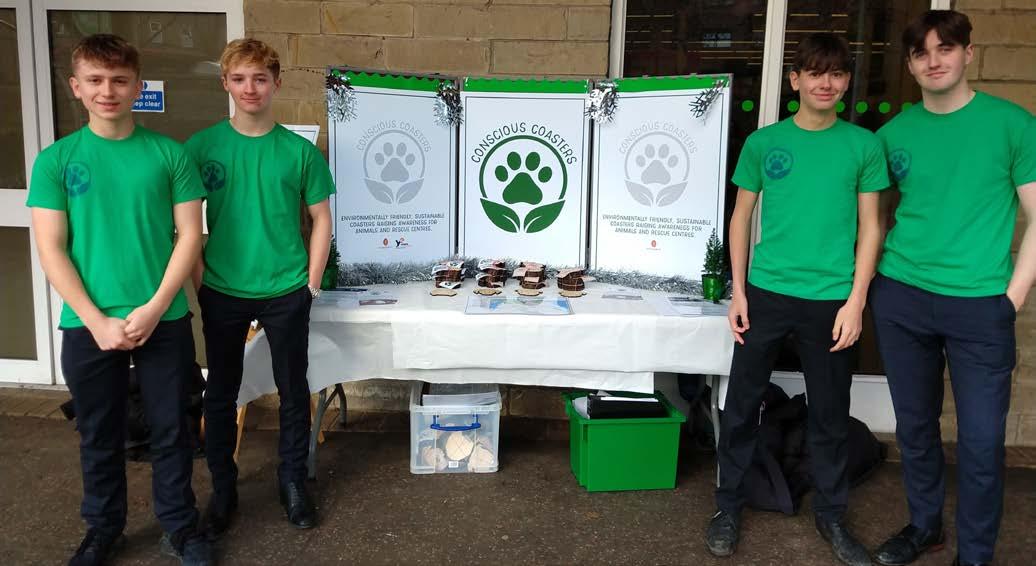
YEAR 10 SPANISH EXCHANGE TO BARCELONA
From the glorious aspect of Gaudi’s architecture, and the tasty tapas, to the marvels on offer in the market of La Boqueria, Barcelona did not disappoint, and this year’s exchange was yet another great success with wonderful experiences enjoyed and new friendships forged.
The students were quick to overcome the anticipated anxiety of being hosted in an unfamiliar city and threw themselves into the challenge of practising their Spanish at every opportunity and engaging with the people and places around them. As has become customary on these trips, food featured prominently, and our daily excursions were punctuated with regular stops to sample the many local and traditional delicacies on offer. Fortunately, plenty of walking between cultural sites and a workout at the open-air beach gym helped burn the odd calorie or two! Beach, bubbles and bouncing were enjoyed by all. The weather was kind to us, meaning that we were able to enjoy lunch and explore the beach at Barceloneta before heading to Barcelona Cathedral, also browsing in the flea market in the plaza whilst dodging the street vendors’ big bubbles. Time spent with the host families was enjoyed by all and trampolining was the activity of choice for group outings. For most, the visit to Gaudi’s La Sagrada Familia and Casa Milà were highlights, the creativity and complexity of Gaudi’s designs proving to be truly inspiring. Whilst heights were not to everybody’s liking, the spectacular views of the entire city from the towers of the various churches and cathedrals visited certainly more than compensated for the not so pleasant lift rides. Our host families welcomed us into their homes with open arms, ensuring that we were always well fed, kept busy and able to improve our spoken Spanish. All in all, it was a wonderful trip and we hope to be able to welcome our new friends to Giggleswick and repay their wonderful hospitality sometime in the near future!
Emma-Jane Wharton
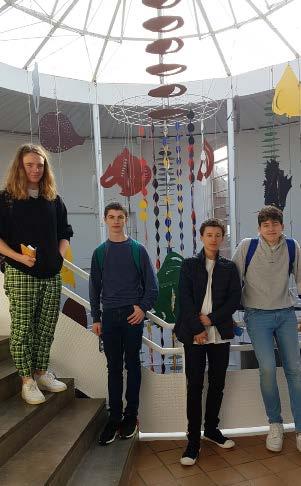
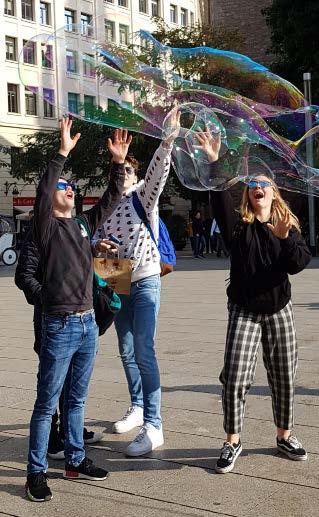
SIXTH FORMERS CONQUER ROME IN THREE DAYS
At its best, education transcends the classroom, and the long weekend trip to Rome was an excellent example of this.
In January, Sixth Formers studying Philosophy and Theology, History, and Classics returned from a life-changing trip to the historic
Italian city. In the space of just three days, starting at 4.45am on Friday, our students visited some of the most iconic buildings in the world, such as the Colosseum and St Peter’s Basilica.
Our pupils experienced great art in the form of the Sistine Chapel and the
Pietà, just two of the many great works by Michael Angelo they were able to see. The walking tour of Mussolini’s
EUR district was a particular highlight, along with trips to the Mausoleo Fosse
Ardeatine and the Museum of
Liberation.
My most abiding memory of this trip will be the sound of ‘wow’ ringing out time and time again as the students discovered yet another fascinating sight which will change the way they view the world for ever. Given the lockdown that followed only a month
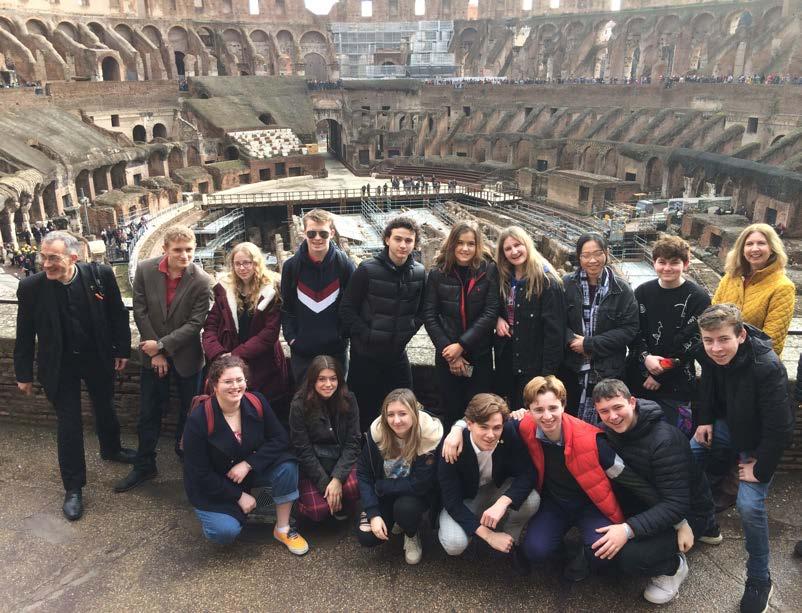
later, we have to consider ourselves very lucky to have managed to complete this trip. So many vivid memories will live on with us all: whether it is the sight of Revd Ladds being dragged back into the restaurant where we had our evening meals, unable to leave until he had quite literally blessed everything and everyone in there; or, perhaps, the sight of students who found their own spiritual pilgrimage and scaled La Scala Santa on their knees praying the Lord’s Prayer as they ascended. In a more secular vein were the moving scenes for the historians among us, who had the terrors of Nazi occupation brought into horrifying reality as they saw the graves of massacred partisans, a reality that to this point had only existed in text books. Or maybe it was the simple sound of laughter and enjoyment that accompanied us all throughout the trip. Here are some thoughts from the students: How can you sum up Rome in less than 200 words? We started by visiting the Catacombs of St Sebastian. It was such an amazing and eyeopening experience, but there’s only so much you can say about dead people. On a brighter note, we did get serenaded by somebody at the restaurant - fine Italian entertainment at its best was definitely experienced on this trip. The following day, some of us partook in climbing Rome’s Holy Stairs, the Scala Sancta, which is a place that can only be described as a stunning visual homage to Rome. Across from the Scala Sancta proudly stood the San Giovanni in Laterano, where we admired the intricate artwork on the ceilings and walls. Whilst in the Vatican, I was overwhelmed when, having studied the statue of Laocoön and His Sons in my Classics lessons for several months, the real thing was right in front of me! Each wrinkle of anguish and emotion depicted in their faces as they struggle to defeat Poseidon’s sea serpents was carved beautifully. It would certainly be remiss of me to not mention the ceiling of the Sistine Chapel, which depicts the biblical story of God’s creation of Earth and Man. Our knowledgeable tour guide directed us to hidden details we would not have otherwise noticed. And of course, none of us took photos of THAT famous painting for the risk of being shouted at by scary Italian guards. I certainly did not expect to be so moved by such an iconic image that transcends all cultures, backgrounds and beliefs. Naturally, we visited the Colosseum, the vastness of which made me realise just how small human beings are. Overall the food, the history, the culture and the architecture all surpassed our expectations: we really experienced the best parts of Rome, ‘doing as the Romans do.’ Ultimately, it was an extremely successful trip. As with all trips, it is fair to say it would not have happened without the support of dozens of staff back at Giggleswick, with a special mention to the bus drivers who took us to the airport at 4am! In addition, to all the parents who supported the students and trusted us to bring them safely home, thank you.

